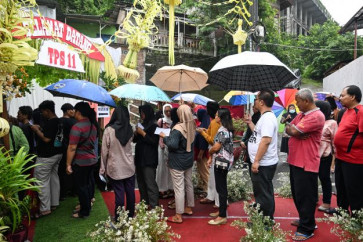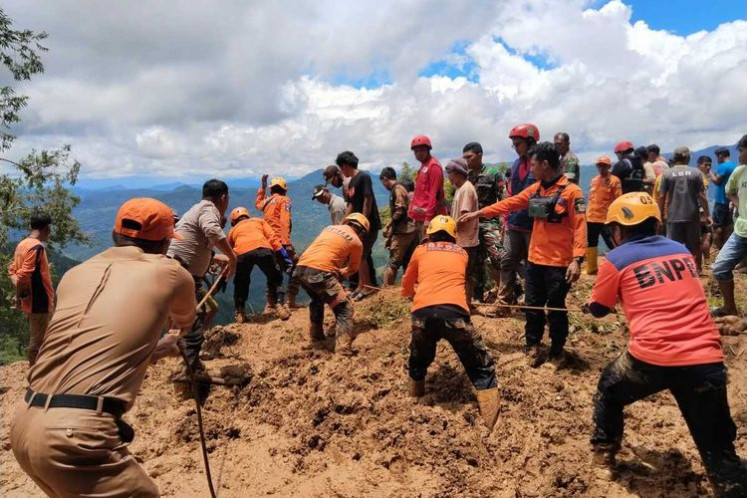'Riders of Destiny': Troubling, visceral photos of child jockeys
Dashing through: Child jockeys race their horses
Change Size

Dashing through: Child jockeys race their horses. The talent for horseback racing is often passed from one generation to the next.
Documentary photographer Romi Perbawa captures breathtaking images of children employed as jockeys in traditional horse racing in West Nusa Tenggara ' though some verge on the gory.
In the eyes of Sumbawa regency officials in West Nusa Tenggara (NTB), horse racing with child jockeys is a fixed schedule in the annual Moyo Festival.
In the eyes of a travel blogger, the long-standing tradition is an exciting story to write.
In the eyes of the horses' owners, it's a business opportunity.
Documentary photographer Romi Perbawa, meanwhile, delves under the surface, following the life stories of a number of child jockeys from 2010 to 2014. He looked at the event from the children's perspective, capturing images showing the reality of their everyday lives, at school and at the races.
The native of Surabaya in East Java went to NTB six years ago as an amateur photographer, aiming to take pictures of the event during a weekend getaway with his wife. He was in the right place at the right time to shoot a child who had fallen from his mount; the boy's cries of pain are almost audible in the photo.
'He fell just in front of me. When I went back to Surabaya, my mind lingered on the children's fate,' he said during a discussion of his photo book earlier this month.
Romi looked into the event, finding that it ran up to 100 days a year, forcing the young jockeys to skip school. At the time he was making the documentary, the youngsters raced without proper safety gear, medical response teams or health insurance, in return for a minimal fee paid to their families.
Determined to tell the underage jockeys' stories, the amateur photographer took a number of photojournalism courses to improve his skills, including at Galeri Foto Jurnalistik Antara in Central Jakarta. He also joined a class held by independent photo editor and mentor Deny Salman, with whom he has kept in touch.
'My pictorial technique skills were a helpful start, but this project needed a different presentation,' he said.
Romi, an employee of a fertilizer logistics company, used his leave to travel to NTB to work on the fledgling project.

The softly spoken and serious man did his homework before pushing the shutter. He also strove to acquire the freedom necessary to get the most intimate shots, from sleeping at locals' houses to joining in the gambling on the races, an illegal activity but nonetheless a major part of the event.
'The more I got involved with their lives, the more I felt the calling [to document them],' he said.
He recalled one moment when he picked up a child jockey from his school, located some 3 kilometers from the boy's house. After they arrived at the boy's traditional house-on-stilts, the second-grader changed out of his school uniform and boiled water in the kitchen to make a cup of coffee for Romi, a heartwarming gesture from such a young boy.
His efforts to build a relationship with the child jockeys are reflected in his pictures. The black and white photos speak a thousand words, capture strong expressions that touch one's heart and freeze moments that bear being looked at over and over.
The photo book is narrated simply, uninterrupted by captions, beginning with introductory pictures of Sumbawa horses and the iconic dry landscape of the island, a picturesque land of hills and inlets. It doesn't take long for the documentary's main characters ' the children ' to appear. We are brought to their homes and playgrounds to see how they live and play alongside the horses.
The emotion intensifies with a picture of a small schoolboy adjacent to one of the same boy decked out in his jockey outfit. Then come pictures of the event itself, preparation followed by race. The viewer's heart accelerates at the sight of the horses flying under the command of their young jockeys, then stops dead at a shot of one fallen youngster.
Accidents are common in races, Romi said, and do not deter families from preparing the next young boy in the household to race.

He demonstrates the longevity of the tradition with a picture of a grandfather, father and two boys. Also included are portraits of the jockeys with their dates of birth listed, a piece of information Romi got from school records ' the boys themselves could not remember.
The book undoubtedly leads us to reflect on the injustice of forcing schoolboys to become jockeys.
It would benefit from an insider analysis of the situation and conditions faced by child jockeys, the province's poverty and the values of the traditional race. It would, moreover, have been interesting to hear the comments ' or at least see the faces ' of the horse owners or officials, those who are at least nominally responsible for the boys' safety and for ensuring they do not miss out on an education.

' Photos courtesy of Romi Perbawa









